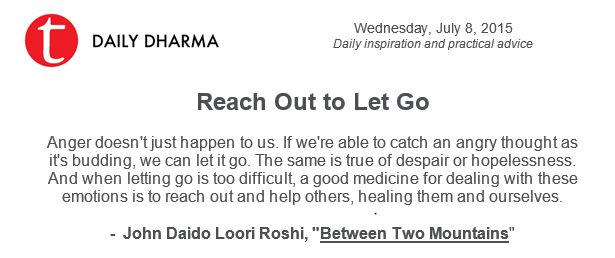
08 Jul Reach Out to Let Go
Between Two Mountains | Tricycle
Originally published in Tricycle Magazine, Spring 2002
For all the horror and trauma that terrorism creates, its lasting power resides in the largely irrational fear we create and then magnify with our minds. Today, statistics show that airplanes are twenty-two times safer than automobiles, yet many people have stopped flying because of the fear that the September 11 attacks engendered. The anthrax scare has caused a widespread reluctance to handle mail, yet only five deaths have resulted from anthrax letters among 30 billion pieces delivered nationwide. We are afraid of death by biological attacks, yet in America some 20,000 people die of the flu each year, and only half of those most at risk get vaccinated. Clearly, the fear of terrorism will not be appeased by providing information, rationalizations, or statistics. It resides in a deep aspect of our consciousness. In order to work with it, we need to understand how it develops.
The force of the recent events has created a series of reactions that many of us are going through. The first is a numbness precipitated by the trauma to our bodies and minds. At this stage, all we can do is sit with the numbness until we're ready to open up and let our feelings arise. When they do, we need to allow them to come up and not suppress them. Because these feelings will be powerful, we may be able to deal with them only briefly. That's okay. We then need to consciously let them go and return to the center of our being, to our still point. After some time, we can begin to work with our feelings again. Depending on the intensity of the trauma, we may need to repeat this process over months or even years.
Some people may have to deal with anger. When we're overwhelmed, an alternative to going numb is to become angry. We set up a target to deflect our feelings away from ourselves, thus avoiding any responsibility for them. Yet, like fear, we create anger by a series of thoughts that result in a particular emotional and physiological state. Anger doesn't just happen to us. If we're able to catch an angry thought as it's budding, we can let it go. The same is true of despair or hopelessness. And when letting go is too difficult, a good medicine for dealing with these emotions is to reach out and help others, healing them and ourselves.
This is not an easy process to go through. The strength to engage it arises out of our meditation practice, our vows to awaken, our commitment to wisdom and compassion, and our spiritual fearlessness.
The fearlessness of the great spiritual teachers like Moses, Jesus, Saint Theresa, Buddha, and Bodhidharma was the fearlessness of the spiritual warrior. Different from stoicism, naïveté, or arrogance, this fearlessness is selfless, generous, and compassionate. Fearlessness is not a matter of ignoring fear, but of really acknowledging it and being empowered by it. We're confident that we can deal with whatever presents itself to us, regardless of the outcome.
In the martial arts, falling down and getting up are not two things; they are one reality. Falling down—failure—is a dimension of returning to one's feet—success. Instead of seeing these two aspects as inseparable, most of us set them against each other, fearing them both. And so we spend our lives caught between two iron mountains: We're afraid of dying, and we're afraid of really living. How do we break free from this prison to advance without hesitation?
When we do not separate ourselves from our fear, we transcend it. Each one of us is born with this same kind of fearlessness, but we need to realize it as our own lives, the life of all buddhas, all beings.
We are living in painful times. From the point of view of the Buddha-dharma, crises are also opportunities to transform our lives. We can shy away from the difficulties, hoping that if we ignore them long enough, they will fade into the cobwebs of our mind. Or we can convince ourselves that we are dealing with them in our practice, while simply suppressing them. Until we honestly go through the process of working with our feelings as they arise, they will just fester within us, waiting to resurface.
We can choose to get lost in our personal terror, but the fact remains that we are the only ones who can heal fear, anger, and pain by the way we use our minds. The ten thousand things, all the barriers, all the peace and the joy of this world, are nothing but the self. The question is, how do we understand it? Now more than ever we need to trust ourselves and let the years we have put into our practice come alive.
John Daido Loori Roshi is the spiritual leader and abbot of Zen Mountain Monastery in Mount Tremper, NY.

